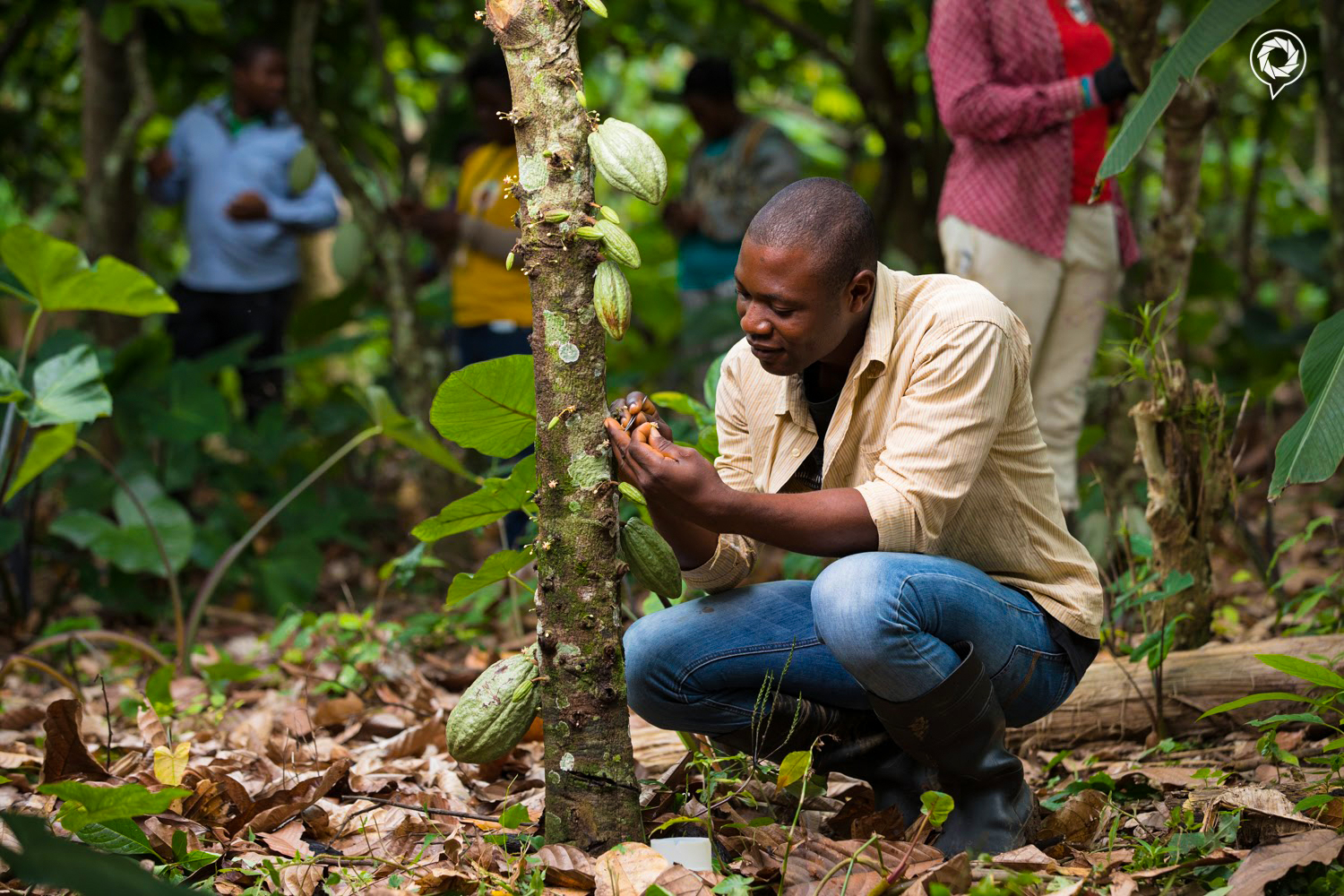LEVERAGING ICT FOR PEAK PERFORMANCE BY CHED

Date: 02nd June 2025
Ghana is one of the world's top cocoa producers and is noted for its best-quality cocoa. The country’s cocoa sector is regulated by Ghana Cocoa Board (COCOBOD). The Cocoa Health and Extension Division (CHED), a division of COCOBOD, is essential in maintaining the standard of cocoa cultivation in the country.
CHED has, over the years, relied on routine activities to support cocoa production, especially in its core extension role. But with the advent of technology, the division may greatly profit from utilising information and communication technology (ICT) to improve its performance and satisfy the expanding expectations of the cocoa sector. In addition to improving operational efficiency, the division can boost farm productivity and raise cocoa yields by adopting state-of-the-art technologies.
This article discusses some possible ways by which CHED can leverage ICT:
1. Empowering Extension Officers with Mobile Technology
Community Extension Agents (CEAs) act as a direct link between cocoa farmers and COCOBOD, so equipping them with mobile technology, such as smartphones and tablets, can increase their effectiveness by way of collecting data on the field and communicating with farmers, which will ensure peak performance in extension delivery.
Real-Time Data Collection: Extension can gather and transmit field data, including reports of pests and diseases, crop conditions, and farmer input, straight to the central database using mobile apps. Faster interventions result from this reduction in the time lag between data collection and response.
Extension officers may easily access a multitude of information on soil health, pest control, and best agricultural practices through mobile apps, which they can then instantly share with farmers.
Monitoring Performance: Supervisors can make sure that farmers receive the appropriate assistance at the appropriate time by using ICT technologies to monitor the performance of extension staff.
For instance, an application like the "Cocoa Health and Extension Mobile App" might facilitate knowledge sharing among extension officers.
2. Utilising GIS and Remote Sensing for Data-Driven Decision Making
Remote sensing methods and Geographic Information System (GIS) technology have the potential to revolutionise the Cocoa Health and Extension Division. These technologies have the potential to yield important information about the condition of cocoa farms around the nation.
Cocoa Farm Mapping: By using GIS to map cocoa fields, extension agents may more easily keep an eye on farm locations, track the stages of cocoa growth, and pinpoint areas that require intervention.
Predicting pest and disease outbreaks, such as the Cocoa Swollen Shoot Virus Disease (CSSVD), requires the use of remote sensing systems to monitor climatic factors, including temperature, humidity, and rainfall. CHED can minimise crop losses by using this data to provide farmers and extension agents with timely warnings.
Targeted Interventions: Resources can be distributed more effectively with the use of GIS mapping and data analysis, guaranteeing that interventions are directed toward the areas or farms that require them the most. For instance, large-scale cocoa crops might be monitored using satellite images to pinpoint locations
3. Using Online Platforms for Training and Education
Enhancing cocoa cultivation methods requires training, knowledge and information sharing, but successful knowledge and information sharing is sometimes hampered by logistical issues. Extension agents and farmers can get ongoing education through online platforms, keeping them abreast of the most recent developments in technology and techniques.
E-Learning for Farmers: Online courses and video tutorials can be offered to cocoa farmers, providing them with guidance on various aspects of cocoa farming, including pest management, pruning techniques, and fertilisation practices.
Webinars and Workshops: CHED can organise online webinars and workshops with experts to discuss topics such as climate change adaptation, pest and disease management, and sustainability in cocoa farming.
Interactive Communication: Social media platforms and online forums can be used for real-time interaction between farmers, extension officers, and experts, fostering a collaborative learning environment.
Example: COCOBOD can develop an e-learning portal where Community Extension Agents and farmers can log in to access practical, on-demand courses or instructional videos tailored to improving their farming techniques.
4. Data Analytics for Monitoring and Performance Evaluation
Incorporating data analytics tools into the operations of the Cocoa Health and Extension Division allows for the continuous monitoring of farm productivity, extension service delivery, and staff performance.
The Cocoa Health and Extension Division can continuously evaluate staff performance, extension service delivery, and farm productivity by integrating data analytics tools into its operations.
Enhancing Yield Prediction: Data analytics can offer predictive insights into possible cocoa yields by gathering information on agricultural methods, weather patterns, and farm inputs. This helps COCOBOD make better forecasts and plans.
Analysing Extension Services: By analysing how various regions are doing in terms of cocoa output and which initiatives were most successful, analytics may be used to monitor extension services in each region as well as district across the seven cocoa regions.
Resource Allocation: Data analysis can help ensure that resources are used efficiently by optimising the distribution of resources (such as pesticides, fertilisers, and extension agents) according to the needs of the farms in a given area.
For instance, COCOBOD can put in place an analytics system that collects farm data and assesses the success of extension initiatives in real time for remedial action where necessary.
5. Mobile-based Financial and Input Support Systems
Cocoa farmers sometimes face financial challenges that prevent them from obtaining high-quality inputs like as insecticides and fertilisers. By offering mobile-based platforms that link farmers with lenders, government grants, and input providers, ICT can close this gap.
Mobile Payments and Lending: Farmers can purchase essential farming inputs on credit, which they can pay back after harvest, by using mobile-based loans or financial products.
Digital Input Distribution: To save time and ease logistical burdens, farmers can order inputs via mobile apps and have them delivered straight to their farms.
For instance, COCOBOD's technology can be coupled with mobile money platforms such as MTN Mobile Money or AirtelTigo Money to enable cashless transactions for loans, input subsidies, and other financial aid for farmers.
6. Strengthening Monitoring Systems and Reporting
Efficient monitoring and reporting are essential for ensuring that cocoa extension programs are being implemented effectively and that the progress of farming communities is being tracked. ICT can simplify these processes and enable transparency.
Real-Time Monitoring: CHED can use mobile apps to monitor the progress of interventions, record farmer interactions, and generate real-time reports on their impact.
Transparency and Accountability: By digitising monitoring and reporting systems, COCOBOD can ensure that funds and resources are being used effectively, which can increase trust among farmers and stakeholders.
Example: A centralised dashboard where CHED managers can monitor the progress of different extension programs and track outcomes in real-time can improve accountability and allow for faster decision-making.
The successful implementation of cocoa extension initiatives and the tracking of agricultural communities’ development depend on appropriate monitoring and reporting. ICT can facilitate transparency and streamline these procedures.
7. Conclusion: A Pathway to Enhanced Productivity
Ghanaian cocoa farmers’ yield might be greatly increased by incorporating ICT into the Cocoa Health and Extension Division's operations. The possibilities for improving farm performance are numerous, ranging from equipping extension agents with mobile devices to employing data analytics to make well-informed decisions. COCOBOD can maintain its position as a leader in agricultural innovation and propel the expansion of Ghana's cocoa industry by adopting digital technologies.
In the end, COCOBOD can establish an ecosystem that benefits farmers and extension agents by utilising ICT. This will result in increased cocoa yields, sustainable farming methods, and a more resilient industry as a whole. Ghana's cocoa sector can be set up for long-term success in the international market by making calculated technological investments.
By Frank Kofi Osei, Regional Extension Officer, Western North Cocoa Region
Other News / Articles you might be interested in.

COCOBOD BOARD CHAIR URGES STAKEHOLDERS TO SAFEGUARD COCOA AS A NATIONAL HERITAGE
The Chairman of the Board of Directors of the Ghana Cocoa Board (COCOBOD), ...
Read More
NO GALAMSEY ON OUR LAND — TUFUHENE OF JEMA VOWS
The Tufuhene of Jema in the Aowin District of the Western South Region, ...
Read More
TREE CROP GRANTS TO BOOST FARMER INCOMES AND JOBS ACROSS GHANA’S GROWING REGIONS
Farmers and agribusinesses in Ghana’s major tree crop–producing regions are set ...
Read More